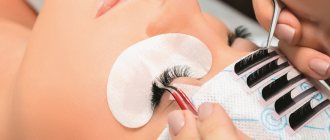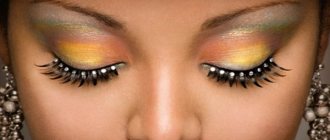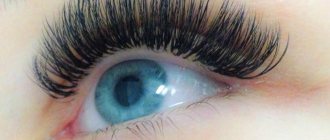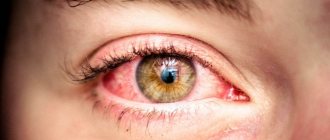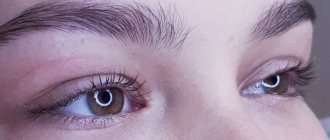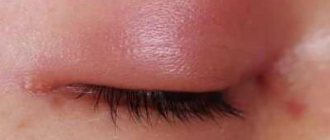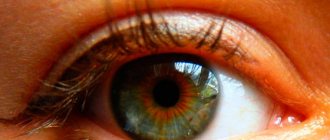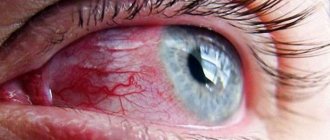There are so many ways to make yourself even more beautiful - but are they all safe for the eyes?
Long eyelashes serve as one of the criteria for female attractiveness. Getting an expressive look couldn’t be easier: almost every beauty salon offers eyelash extension services. The procedure is in demand and available. However, along with beauty, you can also get problems: redness of the eyelids, swelling, irritation.
What to do to avoid unpleasant consequences, and how to relieve eye redness after eyelash extensions: let's figure it out!
Causes of eye redness after eyelash extensions
You should not be alarmed by the redness that occurs immediately after the procedure. Most often, this is caused by the reaction of the ocular mucosa to mechanical and chemical stimuli. The main causes of redness are:
- drying out of the mucous membrane due to the operation of the fan;
- microtraumas (incompetence or inexperience of the master);
- very sensitive skin of the eyelids, prone to irritation;
- allergic reaction;
- individual intolerance to the material or fixative;
- failure to comply with hygiene standards by the master.
Results
Think about it - perhaps beauty is not worth such sacrifices
Eyelash extensions are a simple procedure to perform, and the effect after it is amazing. But, unfortunately, there are also unpleasant consequences in the form of redness and swelling. The reasons for this are very different - ranging from individual intolerance to the materials used and ending with the inexperience of the master.
No one can protect themselves one hundred percent. But before you decide on the procedure, carefully consider whether you are ready to take such risks or whether it might be better to engage in safe eyelash health. You decide. The video in this article contains information about the consequences of eyelash extensions.
Did you like the article? Subscribe to our Yandex.Zen channel
Author
Acceptable redness after extensions
Redness after eyelash extensions is considered normal, which subsides within a few hours after the procedure (in special situations - no more than a day). Often this problem arises due to the natural reaction of the mucous membrane to irritants.
A common factor in eye redness after eyelash extensions is excessive strain on the visual organs. During the procedure, the eyes have to be kept closed for a long time, and since this is not typical for a person during wakefulness, the efforts made can damage small blood vessels.
After the procedure (to reduce the toxic effects of the glue), a fan is required. Directed air movement dries out the mucous membrane, leading to irritation.
The eyes may react red to the protective patches. During operation, they can cause microtrauma (especially often when removed), which causes discomfort.
Sveta
Posted 07/02/2017
During the day my eyes are fine. But when I sleep, they turn sour and turn red. I wash myself, it goes away again. I lie down and close my eyes - everything repeats itself. Three days have passed since the extension.
Answer
Text \ Photo Victoria BOLSHOVA Posted 12/20/2015
+4
share:
To favorites
To print
If you want to thank, add clarification or objection to the author - add a comment!
Currently being discussed:
- Lyubov Burkina
20.08.2018
What hair color should I choose? Please give me some advice. I don't know which one I have...
- I
19.08.2018
I had eyelash extensions for 6 months and took a break. After 3 months I increased it again...
- Vasilisa
18.08.2018
Cool hairstyle
18.08.2018
Hi, can I dye my bleached hair (currently red) bright purple...
16.08.2018
Hello! I am a dark girl with black eyes. I want to dye my hair dark...
15.08.2018
The photo shows young beauties. Can older ladies have their eyebrows done? Age...
Comments »
Contraindications for eyelash extensions
You should not sign up for the procedure if your eyes are even slightly inflamed. Conjunctivitis is one of the most common contraindications. Also, you should not go to the specialist if:
- damage to the mucous membrane;
- frequent diseases (inflammation of the eyelids and mucous membranes);
- tendency to allergic reactions (especially during exacerbation).
Any discomfort or inflammation in the eyes is a serious contraindication to eye extensions. It is not advisable to carry out the procedure for various diseases that reduce immunity (flu, ARVI), this can lead to unexpected complications.
If your eyelashes do not fall out within 5 weeks...
If your eyelashes last a very long time and do not fall out even after normal wear (3-4 weeks), then most likely they are extended monolithically (“one wall”).
With this type of extension, a lot of glue is used, which glues the eyelashes together and the eyelid. It must be said that such “work” not only looks dull, but also significantly harms the eyelids and eyelashes.
It should be? In the process of wearing eyelash extensions, by the third – fourth week, 30-60% of eyelash extensions remain. They thin out gradually as their eyelashes renew themselves. Extensions are not performed on the smallest eyelashes (growing ones), because after 3 weeks it will be a long adult eyelash.
Glued Weighted Eyelashes
Reasons why redness is possible
If chronic diseases are not identified, redness may be caused by unforeseen factors. For example, individual intolerance to the components of glue, new material or an allergic reaction. The effect can occur even after repeated procedures by the same specialist, provided all conditions are met.
Allergic reaction
Allergies can occur even to materials that have already been used. Therefore, a day before extensions, it is recommended to come to the specialist for an allergy test.
Most often, a reaction occurs to glue components, even hypoallergenic ones. Less commonly, an allergic reaction occurs when the eyelid comes into direct contact with the eyelashes.
Individual contraindications
For girls who wear contact lenses, there is a mandatory condition - before the procedure you need to remove them, and then give your eyes a rest for at least a day. It is optimal to replace the lenses with glasses in the first few days. Otherwise, after eyelash extensions, redness will not be the only problem, since the lens material absorbs glue vapors, and the irritated mucous membrane may regard them as a hindrance, which in any case will lead to inflammation.
A tendency to eye diseases will cause not only redness after eyelash extensions, but also an exacerbation of chronic disease. The procedure is also contraindicated for girls with particularly sensitive eyelid skin and mucous membranes of the eyes.
Master's incompetence
It is advisable to visit a specialist only after checking his qualifications. One of the main signs of incompetence that will lead to redness of the eyes after eyelash extensions is failure to comply with basic hygiene:
- insufficient cleanliness of the premises;
- poor (or absent) processing of tools;
- reuse of disposable consumables and tools;
- poor quality and untimely hand treatment.
An inexperienced master can make serious mistakes during work. A common problem for beginners is incorrect extension technology, for example, attaching artificial eyelashes too close to the eyelid or gluing them together. This technique leads to constant mechanical irritation of the eyelid and severe discomfort.
Another problem encountered by careless professionals is that glue gets into the eyes when applying extensions. In such a situation, there is a high risk of getting a chemical burn and even loss of vision.
Symptoms
After performing the eyelash extension procedure, it is worth assessing the body’s reactions. Then you can determine the causes of the problems:
- Eye hyperemia, swelling, dryness - these signs indicate the presence of an allergy. Such reactions are associated with exposure to materials and substances used for extensions.
- Severe tearing, itching, redness of the whites and eyelids - these symptoms indicate an allergy to glue.
- Discomfort when rotating the pupils, redness of the whites - these symptoms indicate a chemical burn.
- Redness of the whites and eyelids, lacrimation, a feeling of a foreign object in the eyes - indicate injury to the mucous membrane of the eye.
- Hyperemia, pain, swelling - these signs indicate the occurrence of an inflammatory process.
If these symptoms persist for 1-2 days, you should consult an ophthalmologist.
Treatment
To cope with discomfort and unpleasant sensations, you should take action quickly. However, if symptoms do not improve within 48 hours of the onset, you should consult a doctor.
First aid
In some cases, help must be provided immediately. For example, if glue gets into the eye. The situation involves rinsing with clean water or sodium hydrochloride solution. If the eye hurts to such an extent that it is difficult to open it, then you should remove the eyelash extensions.
After providing first aid, you must visit an ophthalmologist to prescribe therapy. Only a specialist will be able to determine the danger of the problem and prescribe medications that are optimally suited for a particular case.
On your own at home
You can cope with mild symptoms without the help of a specialist. Pharmacy products will help with this. For example, ointments or drops. Levomycetin drops and Albucid are considered the most effective. Such drugs should be used only if there is no burning, itching or severe pain.
If there is slight discomfort, Erythromycin ointment is also used, which is placed behind the lower eyelid. The medicine helps prevent the development of infection.
Antihistamines are also a necessary component of therapy. You can use both tablets and drops, but it is advisable to combine the means to get results. Dexamethasone, Suprastin, Tavegil are often used.
To relieve symptoms, you can use eye drops with a soothing and moisturizing effect, for example Visin, Bactavit.
Folk remedies
Even if you don’t have any special medications at hand, you can try to cope with the discomfort using traditional methods. One of the easiest ways to relieve irritation is regular black tea. For the procedure, the bags are brewed, cooled and applied to the eyes for 20-30 minutes. You can also use a brewed drink, but for a compress you will have to strain it through several layers of gauze or a clean tea strainer (small debris and tea leaves will only aggravate the redness). Black tea can be replaced with green tea.
To remove redness, you can use decoctions of medicinal plants that have antiseptic properties. Among them:
- chamomile;
- sage;
- series;
- calendula.
A weak decoction is applied to the eyes in the form of compresses for 20 minutes.
If traditional medicine methods do not help, you should immediately consult a doctor.
Have you experienced any side effects after eyelash extensions?
Yes
No
Treatment methods
If a day after the procedure your eyes become even redder, you should consult a doctor. If this is not possible, you can use some medications that will slightly relieve the symptoms. However, it is important to consider that self-medication often provokes negative health consequences.
When treating red eyes, consider the following recommendations:
- If redness is accompanied by severe swelling, lacrimation, and dry mucous membranes, this indicates an allergy to the materials used. Suprastin will help cope with the problem. This antihistamine is taken orally.
- To soothe sore eyes, you can use special drops. The most effective remedies include Vitabact and Opatanol. Such drugs are used twice a day. The course of treatment is 1 week.
- If hyperemia is accompanied by swelling and itching, this indicates microtrauma of the eyelids. In such a situation, it is worth using Visin drops. They help moisturize the mucous membranes and help eliminate unpleasant symptoms.
- If your eyes become infected, it is recommended to use antibacterial drops. These include Levomycetin, Albucid. Such products can only be used as prescribed by a doctor.
- If medications do not help, you should contact a specialist who did eyelash extensions. In this case, the artificial fibers will have to be removed immediately.
You should not remove artificial eyelashes yourself. This causes severe damage to natural eyelashes. But you can alleviate your condition a little by using compresses from herbal decoctions (thyme, chamomile, sage).
The most serious consequence of the procedure is a chemical burn to the eyes. In this case, emergency medical attention is needed. If you receive a burn, your eyes should be rinsed immediately with clean water. It is recommended to do this within half an hour after the onset of symptoms of the lesion.
The master must have a first aid kit. Before the doctor arrives, you must rinse your eyes with saline. solution. The specialist injects Dicaine solution into the conjunctival sac. Subsequent therapy is carried out in a hospital.
In what cases should you consult a doctor?
It is necessary to visit an ophthalmologist in a situation where the eye is very painful and swelling is clearly visible. If unpleasant symptoms do not go away within two days, a visit to an ophthalmologist is urgently necessary.
You should not postpone your visit if there is reason to suspect a chemical burn, infectious infection, or blurred vision. Each of these symptoms can lead to disastrous consequences.
It’s better to play it safe and see a doctor with a minor problem than to endure it and lose your vision or acquire a chronic disease.
Possible complications
Redness of the eye after eyelash extensions is not the worst problem, but if treatment is not started in time, serious complications arise:
- conjunctivitis, inflammation of the eyelids, inflammation of the lacrimal sac, purulent infections;
- serious chemical burn (eg, cornea);
- decreased visual acuity or complete loss.
